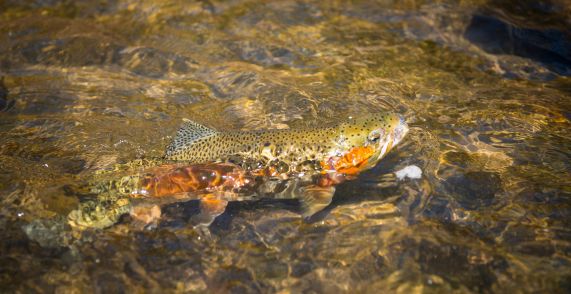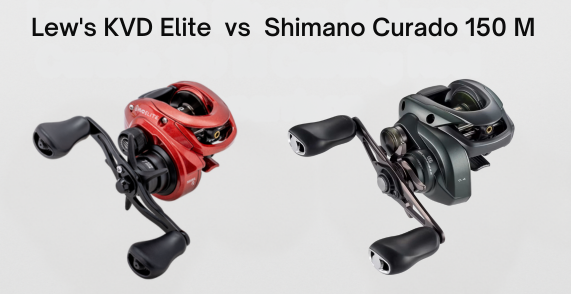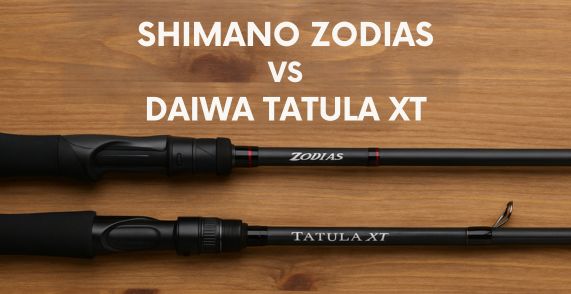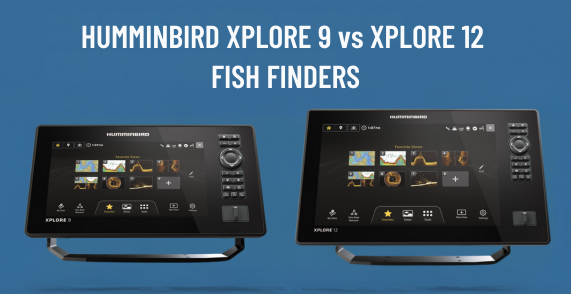As the ancient Chinese proverb goes, “Give a man a fish, and you’ll feed him for a day; teach a man to fish, and he’ll eat forever.”
But how about we refine that wisdom? Teach a person what his target fish loves to eat, and they’ll never return home empty-handed!
So, fellow anglers, have you ever set sail on your fishing endeavors wondering exactly what a trout would favor for lunch?
Today, prepared with scientific insights and seasoned fisherman’s wisdom, we’re delving into the alluring world of leaping trouts‘ preferred cuisines. Let’s uncover the best trout bait for achieving your desired “big catch”.
Trout have a diverse diet that includes aquatic insects, crustaceans, snails, and small fish such as smelt and killifish. Specific prey items vary based on location and time of year. Bait options for trout include live bait such as worms and crayfish as well as lures and jigs designed to mimic their natural prey.
In This Post
What Do Trout Eat?
Trout are known to be picky eaters, and their food preferences vary depending on their species, size, and location. To catch trout successfully, you need to know what they like to eat and when they feed.
Some of the common foods they eat are insects, crustaceans, aquatic invertebrates, small fish, and vegetation. What trout consume also depends on the time of year, water temperature, and location.
Using bait that is similar in color and shape to their natural diet will increase your chances of catching trout. Keep in mind that some baits may work better at certain times of the day or year than others.
There is a wide variety of bait options available for anglers who want to catch trout. Some people prefer live bait such as worms or crayfish, while others use lures or jigs that mimic the movements and appearance of insects or small fish.
Trout are opportunistic feeders, which means they will eat anything that looks appealing and readily available. Understanding their feeding habits can help increase the chances of success when fishing for them.
Think of it this way – if you were at an all-you-can-eat buffet with plenty of options available, you would choose the foods that look most appetizing to you based on color, texture, and smell. Trout act similarly; they choose their meals based on availability and attractiveness.
Fast Facts
- According to a 2022 study, roughly 70% of a trout’s diet typically consists of aquatic insects, especially nymphs and larvae obtained from beneath the water surface.
- A study by fisheries biologists in 2023 found that in smaller ponds and streams, brook trout consume a diverse range of insects, with mayflies, caddisflies, and stoneflies making up about 60% of their diet.
- Research conducted in 2019 on trout feeding habits showed that when given the opportunity or in the absence of preferred food sources, approximately 20% of trout could display opportunistic behaviors, consuming unusual food items such as small snakes or mice.
- Small fish, such as minnows, make up a small portion of a trout’s diet (2-5%).
To catch trout successfully, understand their dietary preferences and experiment with different baits in different locations and seasons. Matching the hatch and using bait that mimics their natural food sources can be a successful strategy.
Prey and Predators
Trout are unique creatures because they can be both predators and prey in various ecosystems. In their early stages of life (fry), they serve as a food source for larger fish species – such as bass, pike, and other predatory fish – as well as birds such as herons and kingfishers.
As they grow larger, trout become predators themselves, and their diet generally includes insects, small fish, and invertebrates. They can even feed on other trout, making them somewhat cannibalistic.
Trout being both predator and prey is much like a game of rock-paper-scissors; sometimes they win, and sometimes they lose.
Since trout eat a wide variety of food, it’s essential to match your bait selection with what’s available in the water body you plan on fishing.
In small ponds that cater to brook trout, insects such as caddisflies, mayflies, and midges make up most of their diet. In larger streams or rivers where brown or rainbow trout are present, baitfish such as sticklebacks and small sunfish are more common.
Types of Bait They Prefer
Trout are known to be opportunistic feeders, and they eat a wide variety of food, including live bait, lures, and jigs designed to mimic the appearance and movement of naturally occurring foods.
One of the most popular baits used for catching trout is worms or grubs. They are an effective choice because they make up a significant part of the trout’s diet, especially in the spring when they are more plentiful. These are readily available at most fishing stores and can be hooked either through the head or tail.
Some anglers even use scented dough baits to attract trout; although they aren’t natural prey, they can still be effective.
Another great bait option is crayfish, which are less visible but loved by trout.
Artificial lures that mimic insects or small fish can also be very effective.
When it comes to choosing the right bait for any given situation, it’s important to take into account where the trout are found and what time of year it is. In some cases, it may be necessary to experiment with different types of bait before finding one that works best.
One experienced angler I know uses salmon eggs as his go-to bait when fishing for trout. He has caught many big trout using this bait and believes it’s because it closely mimics their natural food source.
“Match the hatch” is a well-known principle in fly fishing where you use a fly that corresponds with the insect that is currently hatching on the water. The same concept applies to using bait. If you see that there are grasshoppers jumping around in your area, then using a grasshopper imitation lure will likely work well.
Some anglers believe that live bait should never be used since it may cause unnecessary harm to fish. Others argue that live bait is more effective in catching bigger fish and provides a more natural presentation than artificial lures.
Trout’s Nutrition and Dietary Preferences
As we’ve discussed, trout mostly feed on aquatic insects, particularly nymphs and larvae found beneath the surface of the water. Fish stomach analyses conducted by fisheries biologists show most trout and salmon feed on aquatic insects and fish remains.
Trout also eat small snails, mice, and even other trout. In small ponds, brook trout feed on a wide variety of insects including caddisflies, mayflies, stoneflies, dragonflies, damselflies, beetles, and midges. Depending on the baitfish species available in their habitat, trout may feed on smelts, sticklebacks, shiners, killifish, dace, and small sunfish.
Not all bodies of water have the same abundance of insect and fish species. It’s important to consult fishing regulations to check what is present in specific water bodies before selecting bait.
For example, some of Maine’s best trout ponds have little to no baitfish present which can make it challenging to catch them using traditional methods.
When cleaning a trout after catching it, you can examine its stomach contents to see what it has been eating. This information can be valuable when selecting bait for future fishing trips.
Just like humans; different trout have different tastes and preferences regarding what they eat.
While one creek might have trout that prefer small nymphs or larvae emerging from rocks at a certain time of year, another creek might host fish that seem more interested in larger prey. Understanding this difference plays a vital role in selecting the right bait.
Insects and Invertebrates
Trout mostly feed on insects and invertebrates, including small crustaceans and worms. During the warmer months, they tend to feed on adult aquatic insects such as mayflies and caddisflies, while during colder temperatures, they prefer nymphs and larvae found beneath the surface of the water.
One effective bait for catching trout is imitating these insects with a fly.
Flies are artificial lures that mimic the appearance and movement of naturally occurring insects.
They come in various colors, sizes, and shapes, so it’s essential to choose the right one that matches what the fish are feeding on. Fly fishing requires some skill, but once mastered, it can be an incredibly rewarding experience.
I remember one time I was fishing in a river during early spring when trout were feeding heavily on stoneflies. I switched to a stonefly imitation fly, and within minutes, I was catching fish after fish. It was an incredible experience that reminded me of how important it is to know what your target species is feeding on.
Small Fish and Vegetation
Trout feed on small fish like shiners, smelts, sticklebacks, dace, and killifish.
The type of bait you should use depends on what the trout are eating in your area. If there are no minnows around where you fish or if fishing with live bait isn’t allowed under local regulations, there are many lure options available.
Spoons and spinners are popular lures that can mimic injured, flashing baitfish. They are shiny and come in different sizes and colors to match the forage fish found in the water you’re fishing. Jigs, which imitate small fish and insects, are another type of lure that can attract strikes from trout.
When it comes to vegetation, trout tend to eat freshwater snails, leeches, and various kinds of insects. Using grubs or small plastic worms can be effective in imitating these food sources.
Rubber worms made to look like nightcrawlers or other worms can work well to simulate aquatic invertebrates.
While some anglers prefer using natural bait such as live minnows, others swear by using artificial lures exclusively. In reality, there’s no one-size-fits-all solution when it comes to fishing for trout.
It’s all about understanding the prey items available and how you can replicate them with the bait you choose.
Some fishermen argue that using artificial lures is easier since they don’t need to be kept alive and can be reused multiple times. Others claim that while lures may look identical to living creatures swimming in the water, their scent is non-existent or minimal compared to real live bait.
Using live bait has its pros and cons as well. Since live bait is naturally occurring prey for most fish species, it can increase your chances of catching a big one. However, because they are alive, they require more effort to keep fresh and lively during transport and use.
Fishing For Trout
When it comes to trout fishing, choosing the right bait can make all the difference in reeling in a good catch. Some anglers swear by live bait, while others prefer artificial lures.
No matter what type of bait you choose, there are a few strategies you can use to increase your chances of catching a trout.
Firstly, trout are extremely sensitive to their environment. They can detect vibrations and changes in pressure, which means they can easily spook if they sense something unusual. To avoid this, try to be as stealthy as possible when approaching the water. Walk quietly and avoid sudden movements.
Secondly, consider the depth at which the trout are feeding. If they’re feeding near the surface, try using dry flies or surface lures.
If they’re feeding deeper down, switch to sinking lures or bait. You might also want to experiment with different depths and retrieve speeds until you find what works best for that particular body of water.
Finally, don’t be afraid to try different types of bait until you find what the fish are biting on. As we discussed earlier, trout have a varied diet and will feed on anything from insects to small fish to vegetation.
Keep in mind that their preferences may change depending on the time of year and weather conditions. So be willing to switch things up if your first few attempts aren’t successful.
For example, I once found myself struggling to catch any trout during a particularly hot day in late summer – despite using my usual go-to baits.
A local angler recommended I try using worms instead and after a few casts I was able to reel in several nice-sized trout. It just goes to show that sometimes you need to think outside the box and try something new.
Strategies for Using Different Baits
1. Live Bait: Live bait can be extremely effective at catching trout, especially if you’re using worms or minnows. When it comes to using live bait, it’s important to keep the bait as natural looking as possible. This means avoiding excessive weight on your line and allowing the bait to move naturally in the water.
2. Artificial Lures: If you prefer to use artificial lures, there are a multitude of options out there, from spoons to spinners to plugs. One of the most important things to consider when using lures is the color and size. As we mentioned earlier, different types of lures will mimic different types of prey. So think about what’s naturally available in the body of water you’re fishing and choose your lure accordingly.
3. Flies: Fly fishing is another popular option for catching trout. Similar to artificial lures, there are a variety of flies out there that mimic different types of insects and other prey that trout feed on. Be sure to match the hatch- choosing a fly that matches the type of insect hatching at that moment in time- this will make it more likely that the fish will take your bait.
4. Dough Baits: Dough baits can be an effective lure for catching stocked trout in particular. Dough baits come pre-molded into balls or nuggets and are often infused with scents like garlic or cheese to attract fish.
No matter which type of bait you choose, remember that presentation is just as important as the bait itself. Make sure your bait looks natural in the water by using light weights and ensuring that it moves naturally with the current.
Some anglers believe in keeping their line taut and feeling for subtle bites others prefer letting enough slack into the line so that they can see the line twitching before reeling the bait in- If you have a lot of experience and confidence using live bait, the latter may work best for you.
Think of fishing as a game of trial and error. The fish change their preferences daily, even hourly, so it’s up to you to experiment with different baits, strategies, and techniques. Don’t be afraid to try something new or switch things up if your current setup isn’t working.
When and Where to Find Feeding Trout
Knowing where and when to find feeding trout is crucial for successful fishing. Generally, trout are more active in the early morning and late afternoon when water temperatures are cooler, and they tend to feed more actively during these periods.
In my experience fishing in Colorado, I have found that trout tend to congregate in deeper pools or areas with shade during hot summer days. Fishing near currents or eddies where insects and small fish are swept downstream can increase your chances of catching a hungry trout.
Keep in mind that the location of feeding trout can vary depending on the season and time of day.
For example, during the warmer months, look for trout in cooler, deeper water or near springs where water temperatures will remain lower. In contrast, during the spring thaw or after a rainstorm, trout may be closer to shorelines where food sources have been washed in by the current.
Some fishermen swear by night fishing for trout during certain times of year. While this technique can be effective, it’s important to be aware of the risks associated with fishing at night such as decreased visibility and increased danger from predators or obstacles in the water.
Think of finding feeding trout like searching for a needle in a haystack – you may need to try different spots and techniques before finding success.
Being observant of your surroundings, understanding local conditions and adjusting your strategy accordingly can all increase your chances of landing that elusive big catch.
Don’t be afraid to experiment with different locations, baits or lures until you find something that works. Remember that what worked yesterday may not work today due to changes in weather patterns or water conditions.
By keeping some basic tips in mind and being willing to adapt your approach based on changing conditions, you can improve your chances of catching feeding trout. Whether you’re a seasoned angler or a beginner, there’s always more to learn about this fascinating fish and the best ways to catch them.







